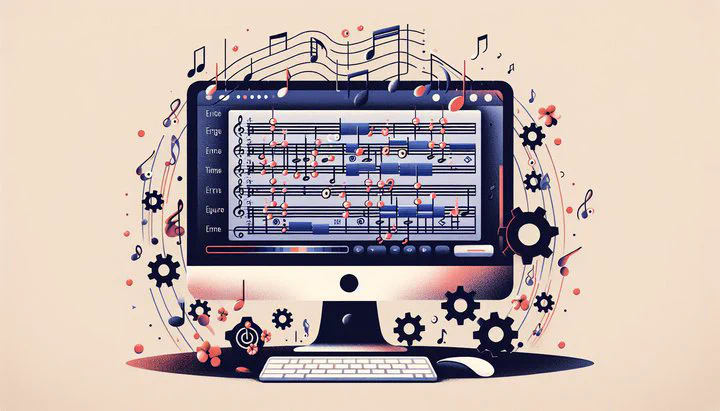Fixing Corrupted Score Errors in Time Signatures

How to Fix Corrupted Score Errors in Time Signatures
Have you ever opened your music notation software, only to find your carefully composed score filled with strange symbols or notes that don’t fit? These are signs of corrupted score errors, and they’re more common than you might think—especially when it comes to time signatures. When working with notation software, musicians often encounter these errors, which can disrupt the creative process and lead to frustration.
Corrupted score errors related to time signatures can occur for several reasons. Sometimes, it’s due to a glitch in the software, or it could be because of an incorrect input that confuses the program. For instance, if you accidentally set a time signature that doesn’t align with your measure count, you might see notes spilling over into the next bar, or measures that don’t add up correctly. This can happen especially with complex pieces where erroneous time signatures causing issues are more likely.
Imagine you’re working on a piece with a 4/4 time signature, but due to a software hiccup, it displays as 4.4.2. This is a classic example of errors with 4.4.2 and time signatures that need immediate attention. These errors not only make your score look messy but can also cause playback problems, where the music doesn’t sound as intended. For educators and students alike, these issues can be a major setback, disrupting lessons and practice sessions.
Let me share a quick story: I once worked with a student who faced this exact issue. She was preparing for a recital, and her score suddenly showed this weird time signature. At first, she felt panicked, but after some troubleshooting, we managed to fix it together, and she learned a lot from the experience.
Understanding the impact of these corruptions is crucial. Not only do they affect how your music looks and plays back, but they can also lead to misunderstandings when sharing scores with others. If a fellow musician opens your file and sees corrupted elements, it can create confusion and misinterpretation, affecting collaboration and performance preparation. Recognizing these errors early can save time and effort down the road, ensuring your music is both accurate and professionally presented.
Troubleshooting Erroneous Time Signatures
When you encounter corrupted score errors time signatures in your music notation software, it can feel overwhelming. But don’t worry! With a few simple steps, you can get your score back on track. Let’s dive into how you can identify and fix erroneous time signatures causing issues.
-
Inspect Your Score: Look closely at your score for any irregularities. Are there extra beats in a measure, or do some measures look too short? These are telltale signs of corrupted score errors.
-
Check Time Signature Settings: Start by double-checking the time signature settings at the beginning of your piece. Sometimes, an accidental change can lead to the whole score needing debugging due to corrupted scores.
-
Use Software Tools: Many programs have features that highlight measures with incorrect note counts. This can quickly point out where the errors with 4.4.2 and time signatures might be lurking.
-
Manual Adjustments: Once you’ve identified the problematic measures, manually adjust the time signatures. Ensure each measure aligns with the intended beat count.
-
Revert to a Previous Version: If manual adjustments don’t fix the issue, consider reverting to a previous version of your score. Regular backups can be a lifesaver here. Compare versions to see where things went wrong.
Finally, don’t hesitate to reach out to online communities for help. Forums and music subreddits are great places to find tips from fellow musicians who’ve faced similar issues. Sharing your experience and learning from others can not only solve your problem but also prevent future headaches. Remember, every musician deals with corrupted score errors time signatures at some point, and together, we can keep our scores in perfect harmony.
Preventing Future Corrupted Scores
To keep your music flowing smoothly, it’s essential to prevent corrupted score errors time signatures before they disrupt your work. Here are some easy ways to keep your scores clean and error-free.
-
Keep Your Software Updated: Always keep your music notation software up to date. Software developers regularly release updates that fix bugs and improve performance. By staying current, you reduce the chances of encountering corrupted score errors related to time signatures.
-
Back Up Your Work: Save your scores in multiple places, like an external drive or a cloud service. This way, if you ever encounter erroneous time signatures causing issues, you can quickly revert to a previous version.
-
Regularly Review Your Scores: After making significant changes, take a moment to play through your piece. This will help you catch any errors with 4.4.2 and time signatures early on.
-
Explore Additional Tools: Consider using additional tools or plugins designed to enhance your notation software. Many musicians find add-ons helpful for managing complex scores and preventing errors. Explore resources recommended by the music community to find tools that best suit your needs.
By following these best practices, you can minimize the risk of needing debugging due to corrupted scores. Remember, with a little care and attention, you can keep your scores looking and sounding their best, making your musical journey as smooth as possible.
In conclusion, tackling these errors might seem daunting at first, but with the right approach and tools, you can overcome these challenges. Keep learning, stay connected with fellow musicians, and remember that every mistake is an opportunity to grow. Happy composing!